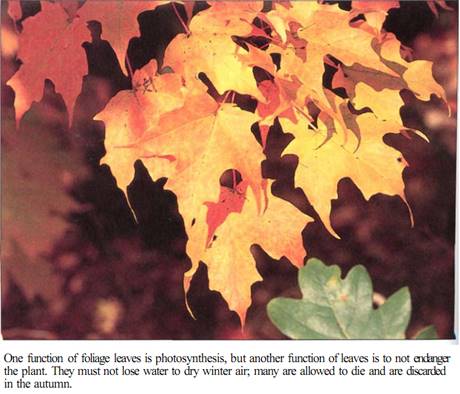


 النبات
النبات
 الحيوان
الحيوان
 الأحياء المجهرية
الأحياء المجهرية
 علم الأمراض
علم الأمراض
 التقانة الإحيائية
التقانة الإحيائية
 التقنية الحيوية المكروبية
التقنية الحيوية المكروبية
 التقنية الحياتية النانوية
التقنية الحياتية النانوية
 علم الأجنة
علم الأجنة
 الأحياء الجزيئي
الأحياء الجزيئي
 علم وظائف الأعضاء
علم وظائف الأعضاء
 الغدد
الغدد
 المضادات الحيوية
المضادات الحيوية|
Read More
Date: 14-11-2016
Date: 13-11-2016
Date: 13-11-2016
|
Introduction to Leaves
The term "leaf" usually calls to mind foliage leaves—the large, flat, green structures involved in photosynthesis. However, natural selection has resulted in numerous types of leaves that are selectively advantageous because they provide protection (bud scales, spines), support (tendrils), storage (fleshy leaves of bulbs), and even nitrogen procurement (trapping and digesting insects). Because protecting a bud from freezing or drying is very different from photosynthesizing, leaf structures and metabolisms that are selectively advantageous for a bud scale are different from those that are selectively advantageous for a foliage leaf. This principle is true for all types of leaves: For each function, certain modifications are advantageous whereas others are not. Studying the various leaf types, their modifications, and the roles they play in the plant's biology leads to an understanding of how structure, metabolism, and function are related.
The shoot system, containing both stems and leaves, demonstrates both division of labor and integration of distinct plant organs. Stems and leaves must function together if the plant is to survive and reproduce, but the optimal features for each organ are quite distinct. Leaves should be flat and thin for maximum absorption of light and carbon dioxide, and most of their tissues must be alive and differentiated into chlorophyll-rich chlorenchyma to carry out photosynthesis. Stems elevate leaves and conduct material to and from them, among other activities. Maximum conduction and support with minimum expenditure of construction material require a cylindrical stem; also, much of the stem— all its tracheary elements and most fibers—must die to be functional. In woody species, new cells are added to the stem xylem and phloem each year, creating a massive wood and bark and an increasingly stronger and more conductive stem. Yearly accumulation of new cells onto leaves is not feasible; such leaves would become bulky, heavy, and opaque— features that would not be selectively advantageous. Almost all leaves contain only primary tissues; secondary production of wood and bark in leaves is extremely rare.
The initial discussion in this chapter centers on foliage leaves because they are the most familiar. Then other leaf types are described and analyzed; by considering how these leaves differ functionally from foliage leaves, it is possible to determine the environmental factors important to leaf structure and how natural selection has produced diverse classes of leaves.




|
|
|
|
4 أسباب تجعلك تضيف الزنجبيل إلى طعامك.. تعرف عليها
|
|
|
|
|
|
|
أكبر محطة للطاقة الكهرومائية في بريطانيا تستعد للانطلاق
|
|
|
|
|
|
|
العتبة العباسية المقدسة تبحث مع العتبة الحسينية المقدسة التنسيق المشترك لإقامة حفل تخرج طلبة الجامعات
|
|
|